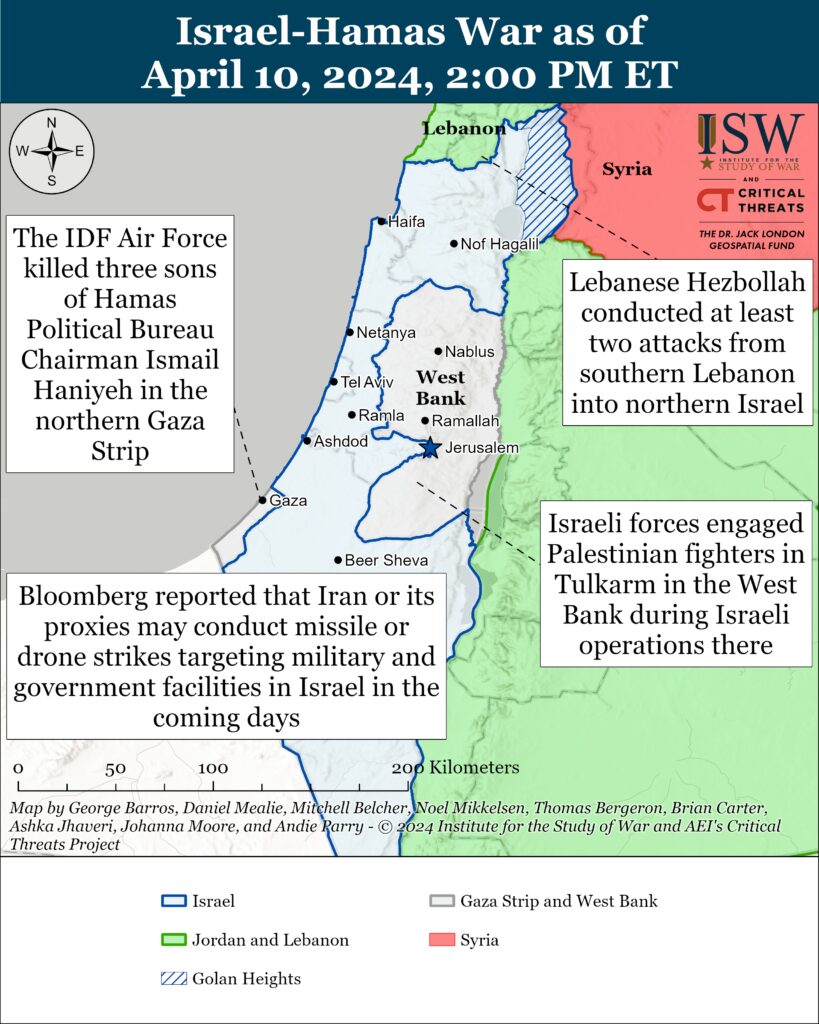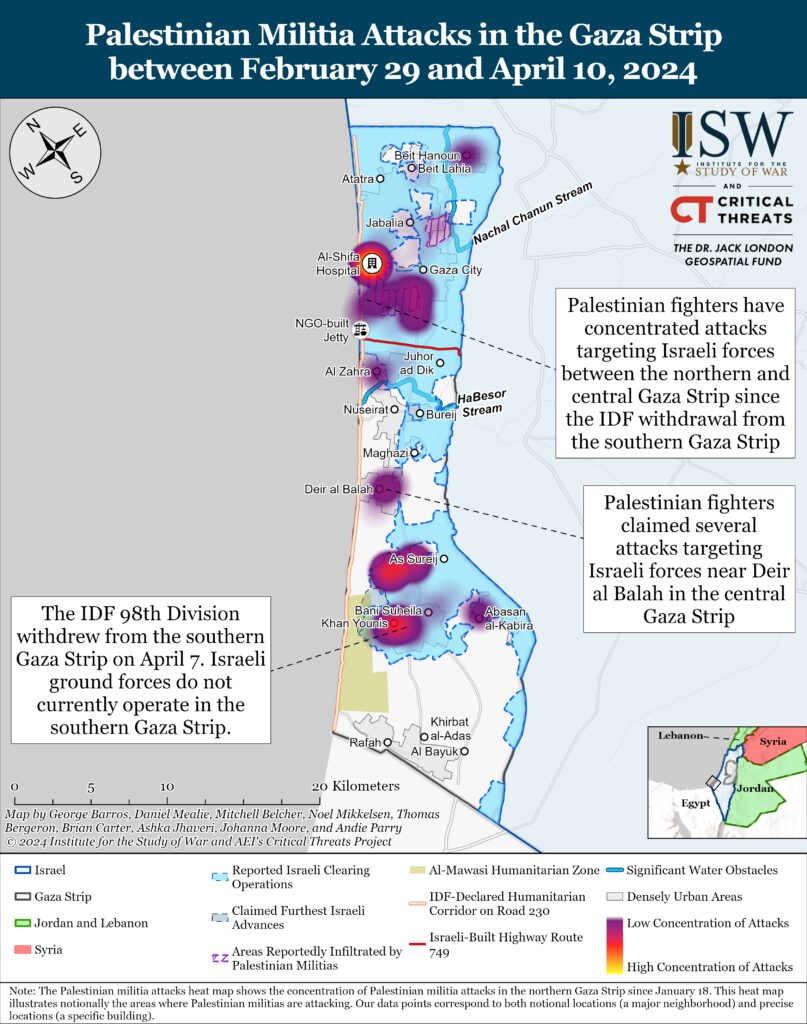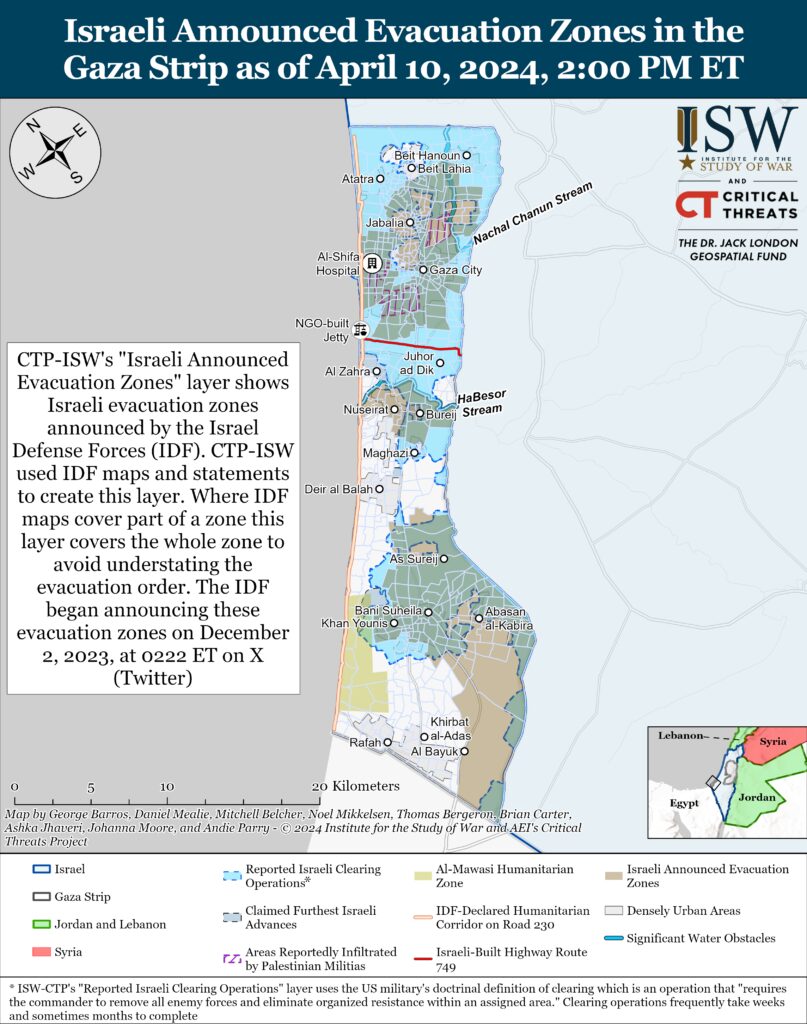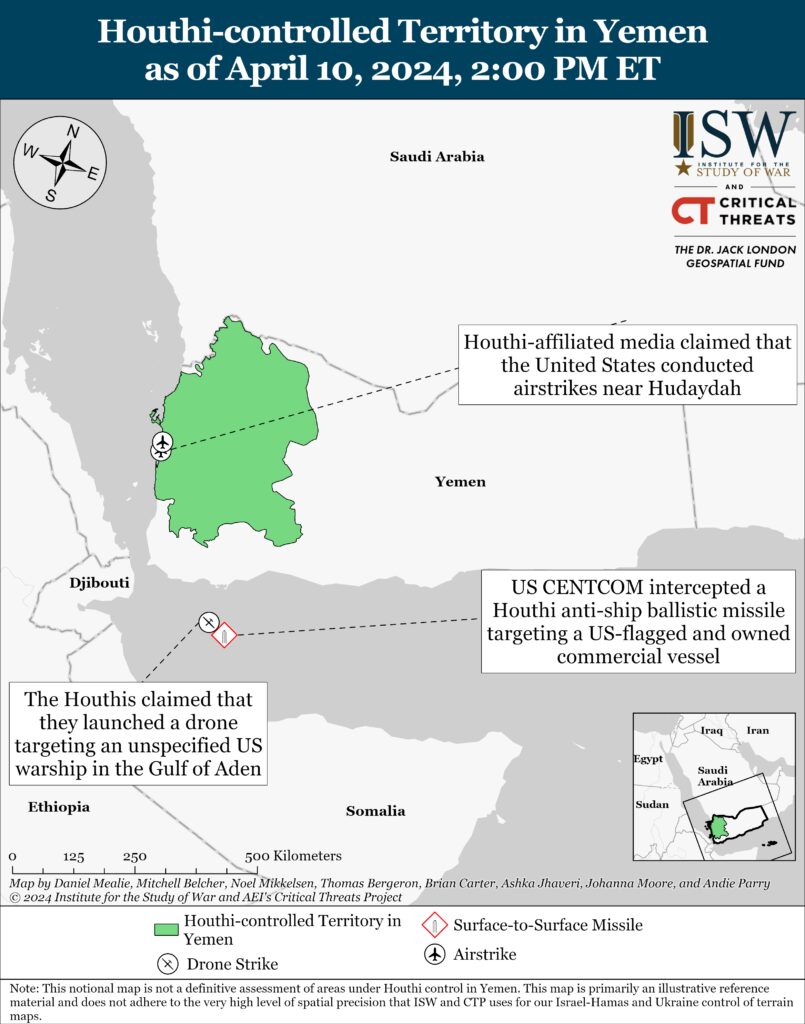Bloomberg reported on April 10 that Iran or its proxies may conduct missile or drone strikes targeting military and government facilities in Israel in the coming days in response to the April 1 Israeli airstrike that killed seven IRGC officials in Damascus.[i] Sources familiar with US and Israeli intelligence told Bloomberg that Iran or its proxies might use high-precision missiles in the strikes. One of the sources said that it is “a matter of when, not if” Iran will respond to the April 1 airstrike. Israeli Foreign Minister Israel Katz warned on April 10 that Israel will attack Iran if “Iran attacks [Israel] from its own territory.”[ii] IRGC-affiliated media dismissed Katz’s warning, claiming that Israel seeks to deter Iran from responding to the April 1 airstrike and warning that Iran must respond.[iii]
The Islamic Resistance in Iraq—a coalition of Iranian-backed Iraqi militias—will not conduct attacks targeting US forces in Iraq as part of Iran’s response to the April 1 airstrike, according to two “knowledgeable sources” who spoke to a UK-based Saudi outlet on April 10.[iv] A “Shia source” told the outlet that Iranian-backed Iraqi militia leaders have had “intensive contacts” with Iranian officials since April 1 and that the two sides have agreed to “continue the calm” in Iraq.[v] Popular Mobilization Forces (PMF) Chief of Staff and senior Kataib Hezbollah official Abdul Aziz (Abu Fadak) al Mohammadawi visited Tehran for Iran’s annual, anti-Israel holiday, Quds Day, on April 5.[vi] Iranian officials and media previously attributed the April 1 Israeli airstrike to the United States, claiming that the United States gave Israel the “green light” to conduct the strike.[vii] The Islamic Resistance in Iraq has not claimed an attack targeting US forces in Iraq since early February 2024.
Israeli Defense Minister Yoav Gallant implicitly warned Iran on April 10 against launching an attack on Israel in response to the April 1 Israeli airstrike that killed seven IRGC officials in Damascus.[viii] Gallant said that Israel knows how to respond with ”decisive offensive action” targeting any actor in the Middle East that attacks Israel.[ix] Gallant’s comments are consistent with warnings from other Israeli officials who have emphasized Israel’s preparation for an Iranian attack and a strong Israeli response to an Iranian attack.[x] Unnamed US, Israeli, and other unspecified Western officials told the Washington Post on April 4 that they expected Iran to retaliate with drones or missile attacks against Israeli targets that would be ”calibrated to avoid an even bigger response from Israel.”[xi]
Asaib Ahl al Haq Secretary General Qais al Khazali hinted on April 10 that Iranian-backed Iraqi militias could resume attacking US forces if Iraqi Prime Minister Mohammad Shia al Sudani’s upcoming visit to Washington, DC, fails to facilitate the withdrawal of US forces from Iraq.[xii] Sudani will travel to Washington on April 15, in part to discuss the status of the US-led international coalition in Iraq with US officials.[xiii] Khazali said that the “success” of Sudani’s upcoming visit to Washington, DC, will depend on whether his visit facilitates the removal of “all foreign forces” from Iraq.[xiv] Khazali warned that Iranian-backed Iraqi militias will force US forces to leave Iraq “if diplomatic efforts fail,” which could be an implicit threat to use military force to expel US force.[xv] Khazali may also be referring to political efforts to expel US forces.[xvi] Iranian-backed political actors have attempted in recent months to pass a law calling for the removal of US forces from Iraq and requiring Sudani to detail how his administration would end the US military presence in Iraq.[xvii]
Iranian-backed Iraqi militias and political actors have been conducting a political and military campaign in recent months to try to expel the United States from Iraq.[xviii] Iranian-backed Iraqi militias conducted over 190 attacks targeting US forces in Iraq and Syria between October 2023 and February 2024. These militias suspended their attacks targeting US forces in February 2024 following a one-way drone attack that killed three US servicemembers in northeastern Jordan.[xix] The pause in attacks also coincided with the start of negotiations between Washington and Baghdad about the status of the US-led international coalition in Iraq.[xx] Some Iranian-backed Iraqi militia leaders have warned since the negotiations began that “[their] patience will not last long.”[xxi] The militias may regard Sudani’s visit to Washington as a decisive moment and could decide to resume conducting attacks targeting US forces if the visit does not result in tangible steps toward removing US forces from Iraq, such as the creation of a timetable for their withdrawal.
Iran and its Axis of Resistance have been engaged in a coordinated campaign to economically isolate Israel by encouraging Muslim nations during the Israel-Hamas war to sever economic relations with Israel. Many senior Iranian leaders have repeatedly urged Muslim nations during the Israel-Hamas war to cut off political and economic relations with Israel.[xxii] Supreme Leader Ali Khamenei called it “treason” for any Muslim country to aid Israel and urged all Muslim nations to cut off economic relations with Israel “at least temporarily” during his speech for Eid al Fitr speech on April 10.[xxiii]
Some Muslim countries have heeded this call, including Turkey. Turkey announced on April 9 that it would immediately restrict the export of 54 key products to Israel in response to Israel’s reported denial of Turkish aid efforts and the Israeli refusal to implement the UNSC ceasefire resolution from March 24.[xxiv] President Ebrahim Raisi stated that Muslim countries cutting off economic relations with Israel is the ”most effective deterrent power” during a phone call with Turkish President Recep Tayyip Erdogan on April 10.[xxv] President Erdogan stated that Israel is more isolated today than ever before.[xxvi] Malaysia banned Israeli-owned and –linked shipping from its ports in December 2023 in “response to Israel’s actions…against the Palestinian people.” The Houthi supreme leader “praised” Malaysia’s position, calling the economic pressure on Israel one way to support the Palestinian cause.[xxvii]
Iran and its Axis of Resistance have also implicitly and explicitly threatened the UAE and Jordan for cooperating with Israel. Supreme Leader Ali Khamenei claimed during his April 10 Eid al Fitr speech that Israel “enters [Islamic] countries” for ulterior motives rather than for the benefit of the host country.[xxviii] Senior Iranian military leaders and its regional allies have recently criticized the UAE for allowing Israel to conduct trade in its territory.[xxix] IRGC Navy Commander Rear Adm. Ali Reza Tangsiri claimed on April 9 that Israel is present in the UAE under the pretext of ”economic work” but actually engages in security and military activities there that threaten Iran.[xxx] Tangsiri issued this statement in an interview with Lebanese Hezbollah-controlled media, likely to pressure the UAE to sever ties with Israel.[xxxi] These statements may also refer to the overland trade route Israel is using to offset its losses cause by the Houthi attacks in the Red Sea. Israel’s overland ground trade routes have taken on new importance after trade decreased at the Port of Eilat.[xxxii] Iranian-backed Iraqi militias also threatened to ”cut” Israel’s ”land bridge” through Jordan.[xxxiii] These militias would probably use missile and drone attacks to generate this effect, given their lack of political influence in Jordan.
Key Takeaways:
- Iran: Bloomberg reported that Iran or its proxies may conduct missile or drone strikes targeting military and government facilities in Israel in the coming days in response to the April 1 Israeli airstrike that killed seven IRGC officials in Damascus.
- Iran and its Axis of Resistance have been engaged in a coordinated campaign to economically isolate Israel by encouraging Muslim nations to sever economic relations with Israel throughout the Israel-Hamas War.
- Iraq: Asaib Ahl al Haq Secretary General Qais al Khazali hinted that Iranian-backed Iraqi militias could resume attacking US forces if Iraqi Prime Minister Mohammad Shia al Sudani’s upcoming visit to Washington, DC, fails to facilitate the withdrawal of US forces from Iraq.
- Northern Gaza Strip: The IDF Air Force conducted an airstrike that killed three sons of Hamas Political Bureau Chairman Ismail Haniyeh in the northern Gaza Strip.
- Political Negotiations: Hamas Political Bureau Chairman Ismail Haniyeh said that Israel would not get more concessions in the negotiations from Hamas after an IDF strike in the Gaza Strip killed three of his children.
- West Bank: Israeli forces engaged Palestinian fighters in Tulkarm in the West Bank during Israeli operations there.
- Southern Lebanon and Golan Heights: Lebanese Hezbollah conducted at least two attacks from southern Lebanon into northern Israel.
- Syria: The IDF said that it struck a Syrian Arab Army (SAA) site that was operated by Lebanese Hezbollah in southern Syria.
- Yemen: US CENTCOM reported that it intercepted a Houthi anti-ship ballistic missile in the Gulf of Aden. CENTCOM assessed that the Houthi attack was likely targeting the US-flagged and owned commercial vessel the MV Yorktown.

Gaza Strip
Axis of Resistance objectives:
Erode the will of the Israeli political establishment and public to sustain clearing operations in the Gaza Strip
Reestablish Hamas as the governing authority in the Gaza StripPalestinian militias conducted several indirect fire attacks targeting Israeli forces in the northern Gaza Strip on April 10. Hamas and the Palestinian Mujahideen Movement conducted a joint mortar attack targeting Israeli forces in southwest Gaza City.[xxxiv] The Palestinian Mujahideen Movement is a Palestinian faction aligned with Hamas that has expressed close ties with Iran. The Israel Defense Forces (IDF) Air Force struck a launch site from which Palestinian fighters had targeted Israeli forces in Shujaiya with indirect fire. Hamas claimed a mortar attack targeting Israeli forces in Shujaiya on April 9.[xxxv]
The Palestinian Mujahideen Movement claimed that it fired a man-portable air defense system targeting an Israeli fighter jet in western Gaza City.[xxxvi]
The IDF Air Force conducted an airstrike on April 10 that killed three sons of Hamas Political Bureau Chairman Ismail Haniyeh in the northern Gaza Strip.[xxxvii] The IDF reported that Haniyeh’s sons were Hamas fighters en route from al Shati camp to conduct an attack in the central Gaza Strip when Israel killed them.[xxxviii] The IDF said that one of the sons was a squad leader and the other two sons were fighters in Hamas’ military wing. The presence of Hamas fighters in al Shati camp is consistent with the infiltration of Palestinian fighters into areas of the northern Gaza Strip where Israeli forces have conducted several clearing operations. It is notable that Haniyeh‘s sons—three Hamas fighters—were using al Shati camp as a rear base to conduct attacks further south, given that Israeli forces re-cleared areas of al Shati in early February 2024.
Several regional leaders, including Iranian President Ebrahim Raisi and Turkish President Recep Tayyip Erdogan, called Hamas Political Bureau Chairman Ismail Haniyeh to offer their condolences following the Israeli airstrike that targeted three of Haniyeh’s sons.[xxxix]
The IDF Nahal Brigade continued clearing operations in the central Gaza Strip on April 10.[xl] The Nahal Brigade killed a squad of Palestinian fighters in close quarters combat.[xli] The Nahal Brigade is operating around the border of the central and northern strip to secure the Israeli highway and bases nearby.[xlii] The IDF reported on April 10 that the Nahal Brigade is conducting targeted operations and raids near the Israeli highway, which the IDF has dubbed the ”Netzarim corridor.” Israeli forces have engaged Palestinian fighters in the area and destroyed military infrastructure, including tunnel shafts. The al Aqsa Martyrs’ Brigades conducted a mortar attack targeting an IDF command site near the Netzarim corridor.[xliii]
The IDF Air Force conducted several airstrikes targeting Palestinian military infrastructure in the Gaza Strip on April 10.[xliv] The IDF destroyed military sites, launch sites, and tunnel shafts.[xlv] The IDF Air Force also targeted a Palestinian fighter squad that threatened Israeli forces.[xlvi]

This map displays engagements between Israeli and Palestinian ground forces across the Gaza Strip. The locations depicted are not exact.


Hamas Political Bureau Chairman Ismail Haniyeh said on April 10 that Israel would not get more concessions in the negotiations from Hamas after an IDF strike in the Gaza Strip killed three of his children.[xlvii] Haniyeh also stated that Israeli leaders “are delusional if they think that by killing my sons we will change our positions.”[xlviii] Hamas said on April 8 that the latest ceasefire proposal does not meet its demands but that it is still reviewing the proposal.[xlix]
Senior US officials continued to discuss a ceasefire in the Gaza Strip. US President Joe Biden expressed support for an immediate six-to-eight-week ceasefire in the Gaza Strip during an interview published on April 9 but recorded last week.[l] Biden also called Israeli Prime Minister Benjamin Netanyahu’s actions in Gaza Strip “a mistake” in reference to the IDF airstrike that mistakenly killed seven aid workers from the World Central Kitchen on April 1. [li] US Secretary of State Antony Blinken said on April 9 that negotiators are waiting on Hamas to make a decision and that “the world is watching to see what [Hamas] will do.”[lii]
An Israeli Army Radio correspondent reported on April 10 that Israel would not open the Erez crossing with the northern Gaza Strip for aid transports.[liii] The Israeli War Cabinet approved on April 5 the imminent reopening of the crossing, which has been closed since the beginning of the war.[liv] The correspondent said that Israel is concerned that protesters could block the crossing and prevent the shipment of aid into the Strip, as they have at other crossings.[lv] Israel will instead establish a new border crossing in a “less central location“ in the northern Gaza Strip to facilitate the transfer of aid.[lvi]
Palestinian fighters did not conduct any indirect fire attacks from the Gaza Strip into Israel on April 10.
West Bank
Axis of Resistance objectives:
Establish the West Bank as a viable front against IsraelIsraeli forces engaged Palestinian fighters in Tulkarm in the West Bank during Israeli operations there on April 9.[lvii] Israeli forces detained nine wanted individuals across the West Bank during overnight operations on April 10.[lviii] Israeli forces detained three wanted individuals and confiscated small arms in Qalandiya near Ramallah and detained six other individuals in Tulkarm.[lix] Israeli forces also seized weapons and money near Hebron.[lx]

This map is not an exhaustive depiction of clashes and demonstrations in the West Bank.
Southern Lebanon and Golan Heights
Axis of Resistance objectives:
Deter Israel from conducting a ground operation into Lebanon
Prepare for an expanded and protracted conflict with Israel in the near term
Expel the United States from SyriaLebanese Hezbollah has conducted at least two attacks from southern Lebanon into northern Israel since CTP-ISW’s last data cutoff on April 9.[lxi]
The IDF said that it struck a Syrian Arab Army (SAA) site that was operated by Lebanese Hezbollah in southern Syria on April 9.[lxii] An Israeli journalist reported that the IDF has claimed two prior strikes targeting Hezbollah in southern Syria on February 3 and March 12.[lxiii] Israeli media reported in 2020 that the SAA’s 1st Corps, which is responsible for areas of southern Syria near the Golan Heights, is closely affiliated with Hezbollah.[lxiv] The IDF did not specify whether it used artillery or aircraft to target the SAA position.

Recorded reports of attacks; CTP-ISW cannot independently verify impact.
Iran and Axis of Resistance
The Islamic Resistance in Iraq—a coalition of Iranian-backed Iraqi militias—claimed that it launched two drones targeting an oil terminal in Haifa, Israel on April 10.[lxv] CTP-ISW cannot verify this attack claim. Israeli officials and media have not commented on the attack at the time of this writing.
Six unnamed Iranian officials and diplomats told Reuters on April 10 that Iran has provided the Sudanese Armed Forces (SAF) with Iranian-made unmanned aerial vehicles (UAVs) over the past few months.[lxvi] An unspecified senior Sudanese army source told Reuters that the Iranian UAVs have helped the SAF ”turn the tide of the war“ by halting the progress of the Rapid Support Force (RSF) and regaining territorial control in areas surrounding the capital. A Netherlands-based independent Sudanese media outlet stated that the drones have been ”decisive” in tactical engagements, allowing the SAF to track, isolate and destroy RSF fighters in the capital.[lxvii] Western media previously reported in January 2024 that Iran had supplied the SAF with Mohajer-6 multirole drones.[lxviii] An unspecified regional source close to Iran’s political elites told Reuters that Iran’s Qeshm Fars Air has transported Mohajer and Ababil drones to Sudan several times since the end of 2023 .[lxix] The Mohajer-6 has a range of 200-2,000 km and uses Almas guided anti-tank missiles and Ghaem guided glide bombs.[lxx] The Ababil drones have a range of 120-480 km and use Almas guided anti-tank missiles and Ghaem guided glided bombs.[lxxi] Reuters did not specify which type of Ababil drones Iran supplied to Sudan. Iran has reportedly supplied drones to Sudan since at least 2019.[lxxii]
The Washington Post reported on April 10 that Iran is rapidly accumulating enriched uranium at its Fordow enrichment facility outside of Qom.[lxxiii] The Washington Post reported that unspecified inspectors have witnessed increased activity at the Fordow facility after the US withdrawal from the JCPOA in 2018. The report also said that the Fordow facility is producing highly enriched uranium at a faster rate than ever before, even though Iran recently sought to dilute some of its highly enriched uranium.[lxxiv] Iran previously claimed that the near-weapons grade uranium discovered at the Fordow enrichment facility in January 2023 was due to an unintended fluctuation in enrichment levels.[lxxv] The IAEA assessed that the information Iran provided to the IAEA was ”not inconsistent” with Iran’s explanation that the near-weapons grade uranium was caused by an unintended fluctation in enrichment levels.
US CENTCOM reported on April 9 that it intercepted a Houthi anti-ship ballistic missile in the Gulf of Aden. CENTCOM assessed that the Houthi attack was likely targeting the US-flagged and owned commercial vessel the MV Yorktown.[lxxvi] The Houthis claimed on April 10 that they conducted two attacks targeting US-flagged vessels, including the Yorktown and an unspecified US warship.[lxxvii] The Houthis also claimed two attacks targeting two ”Israeli” commercial vessels named the MSC Gina and the MSC Darwin.[lxxviii] CENTCOM reported on April 9 that there were no injuries or damage to commercial or military vessels.[lxxix] UK Maritime Trade Operations reported that there were no security alerts from April 9 and 10.[lxxx]
Houthi-affiliated media claimed that the United States conducted airstrikes near Hudaydah on April 10.[lxxxi]

 Eurasia Press & News
Eurasia Press & News



